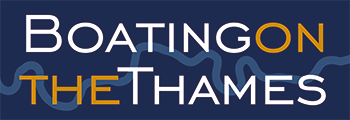

Cruising on the tidal Thames can be a rewarding experience whether exploring the upper river or as the starting point to a cross channel passage. A safe trip requires a sound knowledge of the effects of the tidal stream, including the resultant currents and variable depths.
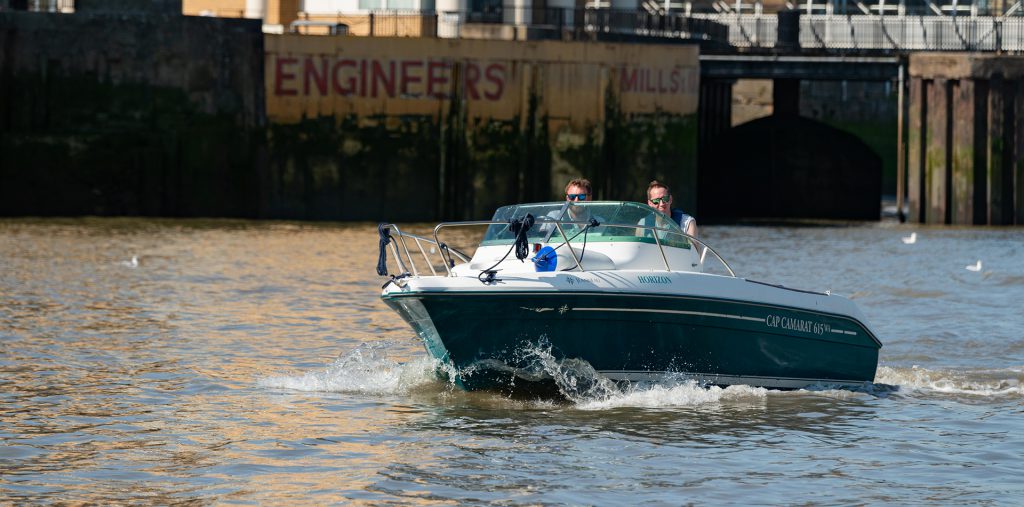
Essential, up to date safety information and advice for water sports participants and those supporting navigation and commercial shipping on the tidal Thames.
The tidal Thames is a unique river, running over 90 miles from the sea to Teddington, with many varied challenges along its length.
In the upper river between Putney and Teddington the channel is narrow with shallow depths, low bridges and many small recreational craft. The middle river, between Putney and the Thames Barrier, is very busy with tugs and tows, fast commuter ferries and day tripping boats all sharing the relatively narrow channel, which is tightly packed within the central London bridges.
Once through the Thames Barrier the river widens and vessels start to become much larger and constrained to operating within the channel.
These different challenges mean effective passage planning is vital and the information provided here should assist the recreational user in safely navigating the tidal Thames.
Key rules for motor boating on the tidal Thames
As the tidal Thames is linked to the sea, all vessels need to follow the ‘International Regulations for Preventing Collisions at Sea’ (“Col Regs”). You can read the rules in full here
(There are other local byelaws that relate to rights of way with other vessels, which will be explained further below.)
The main basic rules are:
- KEEP TO THE RIGHT
- KEEP A GOOD LOOK-OUT at all times, BEHIND YOU as well as in front
- If you find yourself approaching another vessel head-on, you should sound one short blast and keep to the RIGHT (STARBOARD)
- When entering the river from a lock, pier or berth do not cross in front of another vessel
- At bridges, use the most starboard arch available to you provided it does not compromise your safety. (See the specific navigation advice for different areas of the river below, for more advice.)
Our byelaws contain rules which supersede some of the International Collision Regulations. For example:
- a vessel must not cross or enter a fairway so as to obstruct another vessel proceeding along the fairway.
- a vessel navigating above Cherry Garden Pier must not impede the passage of
- a vessel of 40m or more in length (above Westminster Pier, this length reduces to 20m)
- a vessel engaged in towing
Navigating in fog or restricted visibility
Navigating in restricted visibility is not an activity that the PLA recommends that any sport, leisure or recreational boaters should undertake on the tidal Thames. No attempt should be made to get underway when visibility is less than 200m and should you already be underway during an outing, you should find a safe haven as soon as reasonably practical.
Should the Master of a vessel decide to navigate in restricted visibility, they must have a comprehensive understanding of the International Regulations for Preventing Collisions at Sea, 1972 (COLREGs), in particular Part B (Steering and Sailing Rules) both Section III (Rule 19) – Conduct of vessels in restricted visibility and Section I (Rules 4 to 10 inclusive) – Conduct of vessels in any condition of visibility.
Put simply:
- A rigorous lookout should be maintained – by sight, sound and any means necessary
- Navigation Lights are operational
- Radar, if fitted, is setup appropriately and utilised to assist you in navigating in fog however it should not be solely relied upon but it is an incredibly useful aid to your navigation
- Navigate at a safe speed to ensure effective action can be taken to avoid a collision.
MGN 369 – Navigation in Restricted Visibility contains further guidance.
Small vessels can also vastly improve their detectability by using AIS. An AIS transceiver can also assist small vessel crews in the early detection of ships, as well as showing names, call signs, speeds and headings of vessels in the locality to improve situational awareness.
Speed Limits
There are speed limits on the tidal Thames for your own safety and that of others. In summary:
- Do not to exceed a speed of 8 knots above Wandsworth Bridge
- There is a strict 12 knot speed limit throughout central London. This limit applies between Wandsworth Bridge and Margaretness (which is located near Barking Creek)
An 8 knot speed limit also applies in all creeks linked to the tidal Thames and the inshore area off Southend. The limit is advisory at Coryton and Thurrock when tankers are berthed.
[NB: Some vessels issued by the PLA with a valid Certificate of Compliance can exceed the limits listed but only between Margaretness and St Saviour’s Dock, and between Lambeth Bridge and Wandsworth Bridge. The vessels which hold this certificate are mainly commercial passenger operations, and PLA / emergency services craft. These ‘High Speed Zones’ are shown on the Recreational Users Guide
(Please refer to Port of London Thames Byelaws 2012 for the full limitations)
Wash
At times the wash, or wave height, on the Thames can be powerful. The steep river walls reflect, rather than dissipate, the wash so it can be particularly rough at high water during busy traffic periods. The Thames is classified as ‘Category C’ and ‘D’ with wave heights of up to 1.2m and 1.5m respectively, so vessels should be suitable for the conditions.
Before navigating on the tidal Thames
Ensure you have planned your passage; taken into account the tide times; made bookings with any locks; and checked the weather and ‘Fluvial Flow’ guidance. Check our Notices to Mariners page for anything that may affect your journey, such as river closures and bridge maintenance.
Everyone on board a recreational craft navigating on the tidal Thames should wear a lifejacket. The river is cold and fast flowing and can be harsh and unforgiving.
Pre-passage checklist
check you have sufficient fuel, oil and water for the passage
- check your bilge pumps operate correctly
- check the stern gland greaser is topped up and operates correctly
- check there is nothing wrapped around the propeller
- check the weed hatch is securely fastened down
- check the horn is working correctly
- check the steering is working correctly
- check your anchor is correctly attached and ready to deploy (See equipment section below)
- on a narrowboat, ensure all outer doors are secured
- when travelling during the hours of darkness, ensure that navigation lights are working correctly
- for applicable vessels ensure that a kill cord is worn at all times
Entering the tidal River Thames
Contact “London VTS” (Vessel Traffic Service. See contacts below) with:
- The name of your boat
- where you are entering the tidal Thames and your destination
- the time you expect to be on your way
- the number of people on board
VTS can pass any pertinent navigational information to you too, such as river closures or bridge arch closures. They are likely to advise you on the arch through which you should navigate.
Always be aware of traffic moving up and down the river and enter the tidal Thames only when safe to do so.t
VHF marine radio
We strongly advise all vessels to carry VHF, though VHF is only required for vessels above 13.7m.
(NB: exemptions exist for vessels travelling in a flotilla or convoy above Greenwich.)
You should monitor VHF Channel 14 when between Teddington, through central London to Dagenham (Crayfordness). Below here, monitor Channel 68 until Southend Pier where Channel 69 then takes over.
If there is no VHF radio on board, the person in charge of navigation of the vessel should report to the London Vessel Traffic Service (VTS) by telephone (0208 855 0315 west of Dagenham, 01474 562215 east of Dagenham) prior to entering the tidal Thames.
Most chandleries sell VHF handsets, along with the ‘Ship Portable Radio Licence’ required for a VHF Digital Selective Calling (DSC) Handset. Contact your local chandlery for more advice on this.
If coming from the non-tidal Thames, Lindon Lewis Marine at Shepperton offer a VHF rental service. They can also supply river user guides and help with passage planning. (www.pushtheboatout.com)
Note: An RYA ‘Short Range Certificate’ (SRC) is the minimum requirement to use a VHF or VHF DSC radio (unless It is an emergency situation when anyone may use the radio to call for help) as well as appropriate licenses from OfCom. Contact OfCom and the RYA for more information.
Teddington to Brentford (Part of the ‘Thames Ring’)
The Thames Ring route uses this 4 mile section of the river Thames. It requires extra preparation and skill compared to the canals. You should ask for the advice of the lock keepers at either Brentford or Teddington regarding the timing of your passage. They will ensure that you get the maximum benefit of the tides.
The river from Teddington to Putney is very busy with rowers and paddlers. Take a look at our rowing and paddling pages to become familiar with what to expect.
The river is narrow with very little water in places, so plan your passage carefully. We suggest avoiding low water when navigating in this stretch of river. Low bridges present an additional hazard.
If leaving Brentford and heading upriver to Teddington Lock, we suggest you do this on a rising tide. This will allow passage through the open half-tide barrier at Richmond and means you won’t have to “punch” against the tide as you travel upriver.
If you are travelling from Teddington Lock down to Brentford, we suggest leaving Teddington at High Water and travel on a falling tide to arrive at Brentford around one hour later. This should enable a safe turn to LEFT (PORT) when entering Brentford Creek.
You can find tide tables on the Port of London Authority site.
Tide times for Richmond Lock will be suitable for this journey. (Brentford Lock is only available to use 2 hours either side of High Water.)
Bridges
Two orange lights side-by-side mark aches which lie within the navigable channel. To the west of Putney, you should use the arch with these orange lights which is furthest on the starboard side. You can use arches not marked by these orange lights where depth and height allow.
Locks
When navigating on the tidal Thames, there are locks which are operated by different agencies. Some can be found on our Thames Map, and we highlight some of the more popular/regular sites:
Thames Lock Brentford
This is owned by Canal and River Trust (CRT), they request that you must book the lock at least 48 hours in advance by either calling 0303 040 4040 or emailing CRT’s customer service team stating when you wish to book passage through Brentford Lock in the message box. You can also book online. Please note: the CRT team works 9.00am to 5.00pm, Monday to Thursday (and 9:00am to 4:30pm on a Friday, with last bookings taken at 3:00pm on a Friday).
Limehouse Lock
Limehouse Lock is operated by Aquavista and is not available for around two hours either side of low water at London Bridge. In the summer (1 April to 30 September): the lock is open between 8.00am to 6.00pm. It’s also possible to use the lock from 5.00am and to 10.00pm if it is booked 24 hours in advance. In the winter (1 October to 31 March): the lock is open between 8.00am to 4.00pm. It’s also possible to use the lock from 5.00am and to 10.00pm if it is booked 24 hours in advance. To book the lock, you need to call Aquavista, formerly known as British Waterways Marinas, in advance on 020 7308 9930.
Bow Lock
Bow Lock is owned by Canal and River Trust (CRT), which must be booked 24 hours in advance. Availability is restricted to two hours either side of high water at London Bridge between 5.00am and 10.00pm. To book the lock, call 0303 040 4040 or emailing CRT’s customer service team. You can also book online.
West India Dock Entrance
West India Lock is owned by Canal and River Trust (CRT), which must be booked in advance. Availability is restricted to one hour either side of high water at London Bridge (minus approximately 20 minutes) between 7.00am to 4.30pm. Only where you have a confirmed berth or booked visitor mooring is there no charge. Plus, you’ll need full salvage cover / wreck removal insurance to enter West India Dock. To book the lock, call West India Marine Control on 0303 040 4040 or emailing CRT’s customer service team. You can also book online.
Teddington Lock
Teddington Lock is owned by the Environment Agency, which is manned 24/7 and does not require booking. The lock office telephone number is: 02089 408723
Richmond Lock and Half Tide Weir
Richmond Lock is owned by the Port of London Authority, is manned 24/7 and does not require booking. A fee is payable if using the lock. However, for around 2 hours either side of high water, the weir sluice gates are raised, allowing free passage of craft. Where possible, schedule your transit to pass through the barrier during this time. The lock keeper can be contacted on: 0208 940 0634 and further details about the lock can be found here.
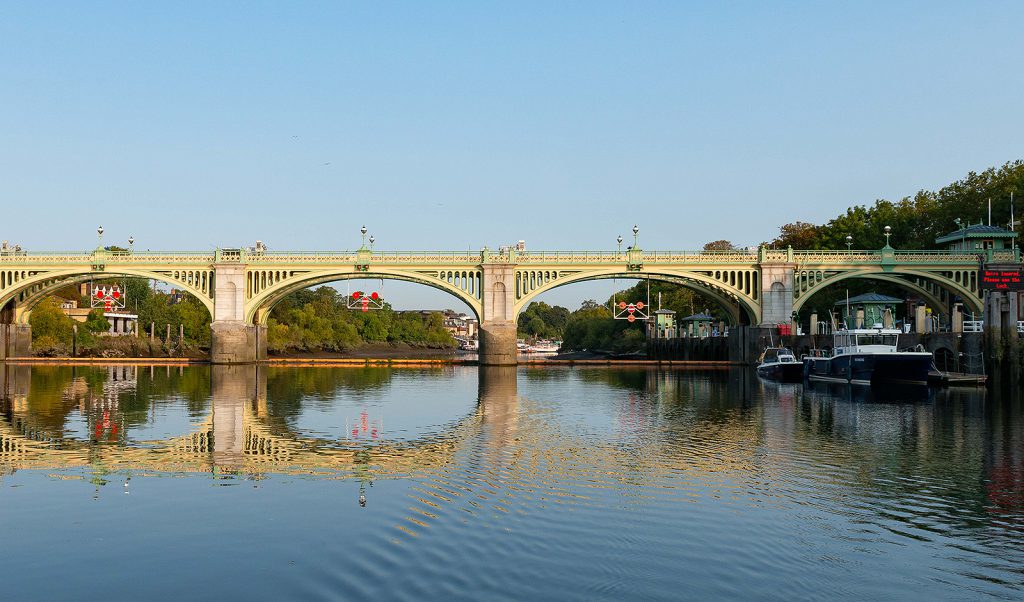
The Thames below Brentford (Part of the ‘London Ring’ to Limehouse)
The river below Brentford presents a variety of challenges. Down to Putney the river is used extensively by rowers and paddlers. Take a look at our rowing and paddling pages to become familiar with what to expect.
The Thames is the busiest inland waterway in the UK. The planning of your passage is essential. You will need to carefully plan your departure and arrival times around the tides, even more so than between Brentford and Teddington, due to the distance (approximately 15 miles between Brentford and Limehouse) and Limehouse and Brentford Locks only being available at certain tides. (Limehouse is not available to use 3 hours either side of Low water)
The PLA Shop contains charts, bridges guides and tide programs to help you plan your passage.
We suggest, particularly for your first journey through London, to plan your passage for the quieter traffic times. This tends to be early mornings on weekends. From around 10:00, the weekend passenger services begin to start. During the week, these begin much earlier.
Downriver transits to Limehouse from Teddington or Brentford should begin no later than 1 hour before High Water. Depending on your vessel’s speed and the tide height, you should arrive at Limehouse Lock with enough water to use the lock. (Passage time of 3 hours assuming an average speed over the ground of 5 knots)
* TAKE CARE WHEN CROSSING THE RIVER TO LIMEHOUSE. YOU MUST NOT CROSS IN FRONT OF OTHER RIVER USERS.
If you wish to take a more leisurely trip down to Limehouse and avoid the possibility of missing your window for locking through, we suggest you find a visitor’s mooring. Piers such as Putney Pier, Plantation Wharf, Imperial Wharf (Chelsea) and Chelsea Harbour Pier offer berths for you to moor up and wait for a more favourable tide, so you can be well rested and well prepared before coming through the busier part of the river. This would allow you to plan your passage with the tide down to Chelsea, wait for the next High Water and then have plenty of time to transit through London to Limehouse. You can find details of visitor moorings here. Other facilities can be found on our Thames Map.
Upriver transits from Limehouse to Brentford or Teddington have slightly more relaxed time and tide constraints, due to High Water at Teddington being 1hr after High Water in central London. Leave on the ‘flood’ tide, allowing sufficient time to get to Brentford or Teddington before the tide turns.
Traffic
River traffic in central London can get very busy, particularly at peak times in the summer months. The areas around the Tower of London and Westminster / London Eye are especially busy, due to crossing vessels and sight-seeing passenger vessels.
Avoid impeding commercial craft wherever possible. They can be difficult to manoeuvre, take a long time to stop and may be confined to a small part of the river where there is just enough water for them.
Take particular caution when near vessels navigating with the tide behind them. This makes the steering and stopping of large vessels more difficult than normal. If you are navigating against the tide, be prepared to stop or give way to vessels coming the other way.
Bridges
Through central London, the majority of bridges have multiple arches to choose from. You should use the arch which is furthest to the starboard side, where depth and height allow. 2 orange lights side-by-side mark aches which lie within the navigable channel – these, particularly the centre arches, are used by commercial vessels. You can still use these arches provided you remain on the starboard side of the river and you don’t impede commercial vessels.
Watch out for a white flashing light on the bridges. If it flashes, you MUST NOT USE THAT ARCH due to large craft or tugs approaching that arch. You must keep out of their way. They are restricted in their manoeuvrability due to their size, weight and the bridge arches.
Below London through to the estuary
If you intend to head to the east of London passed the O2, click here for guidance for the Thames Barrier.
Navigating in the upper tidal Thames
Navigating in central London
Navigating in the lower tidal Thames
Visitor moorings
There are several visitor moorings available on the tidal Thames. Most yacht clubs, cruising clubs and marinas should be able to offer some moorings.
You must obtain permission from the berth or mooring owner before using any facility.
Vessel construction and equipment
The tidal Thames is categorised by the MCA (Maritime Coastguard Agency) as a ‘Category C’ waterway down as far as Gravesend. This means that you can expect wave heights of 1.2m, so it is important to ensure your vessel and the equipment it carries is up to the task. (This increases to ‘Category D’ downriver of Gravesend.)
We recommend the following equipment when navigating on the tidal Thames:
- lifejackets: approved by MCA or under the Marine Equipment Directive (MED), or should comply with BS EN 396: Lifejackets and personal buoyancy aid of 150N, or BS/EN 399: Lifejackets and personal buoyancy aids of 275N
- a VHF set (mandatory for some vessels)
- mobile phone (in a waterproof pouch) and kept on your person at all times
- water resistant torch
- boat hook
- appropriate first aid kit
- navigation lights
- ropes for mooring the vessel and for towing
- minimum of one 12kg anchor, attached to a designated strongpoint by 5 metres of 6mm short link chain and 25m of 12mm rope.
Additional information from the RYA:
An AIS transponder (Automatic Identification System) is of great benefit. An AIS transceiver can assist small vessel crews in the early detection of ships, as well as showing names, call signs, speeds and headings of vessels in the locality to improve situational awareness.
For some vessels, particularly narrow boats or boats that were designed for canals and non-tidal rivers, the distance between the water and vents, hatches or drains may be quite small. Safety Bulletin No.1 of 2012 was published following an incident where there was inadequate freeboard or safety clearance.
The recommendations are as follows:
- The tidal Thames is classified as Category C waterway, where wave heights of up to 1.2m may be encountered. Vessels should be suitably prepared to meet these conditions.
- Through hull fittings, vents and exhaust outlets should be positioned as high up as practicable on narrowboats to meet the conditions likely to be encountered. Where through hull fittings, vents and exhaust outlets cannot be moved to a safe location consideration should be given as to whether the vessel is suitable to navigate on the tidal Thames.
- Where modifications have been made, such as the extensive use of double plating, it is important to check sufficient safety clearance remains for the vessel to safely navigate.
- Lifejackets and other safety equipment should always be provided on board vessels navigating on the tidal Thames and it is strongly recommended that lifejackets are worn at all times when on deck.
It is important to ensure that the engine and controls of the vessel are in a good state of repair. Following a series of easily available incidents where mechanical breakdowns were the cause, the PLA published Safety Bulletin No.3 of 2014.
Licensing and certification
Although there is not a legal requirement for the person in charge of a recreational craft or ‘pleasure vessel’ to have a formal qualification, the tidal Thames is not for novice or inexperienced people. A good degree of boating knowledge and experience is needed before venturing on to this complex and challenging river.
The RYA has a wide range of courses which assist boat users to become safe and proficient.
Note:
- vessels that are hired or chartered are not considered to be pleasure vessels.
- a vessel carrying more than 12 passengers is not classed as a pleasure vessel, but would come under the definition of a ‘passenger vessel’. The vessel and the skipper would then require appropriate licences from the Maritime Coastguard Agency (MCA). Contact your local MCA office for further details.
Advice on safely enjoying the tidal Thames from the Port of London Authority.
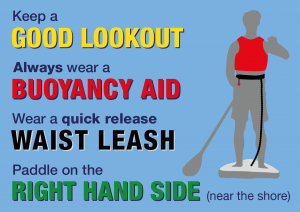
Stand-up Paddlers Safety Card
The Stand-up Paddlers Safety Card offers advice on staying safe on the River Thames while paddleboarding.
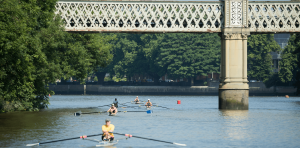
Ebb Tide Flag Warning
The latest Port of London Authority advice to river users about the current tidal fluvial flow on the River Thames.
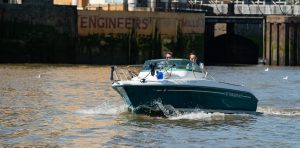
Information on the Regulations Applicable to Pleasure Vessels
Pleasure craft can be considered to be vessels that are used for sport or recreational purposes only and do not operate for any financial gain to the owner.
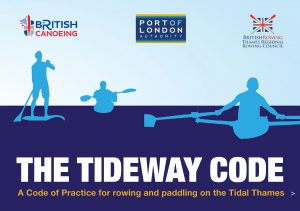
The Tideway Code
Navigating any type of small recreational vessel on the tidal Thames, or Thames Tideway as it is also known, requires knowledge of the river and how it operates.

Recreational Users Guide
Navigating any type of small recreational vessel on the tidal Thames, or Thames Tideway as it is also known, requires knowledge of the river and how it operates.
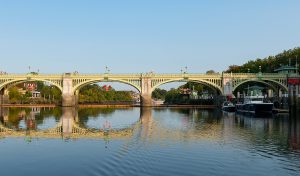
Vessel Licensing Byelaws 2014
Navigating any type of small recreational vessel on the tidal Thames, or Thames Tideway as it is also known, requires knowledge of the river and how it operates.
Boating Links
External sites of interest to cruisers.

Royal Yachting Association: Activity Finder
Find water-based activities and choose from a variety of interests the the Royal Yachting Association’s activity finder.
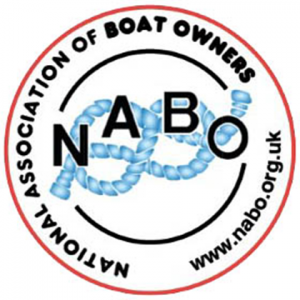
National Association of Boat Owners
National Association of Boat Owners is a UK inland boating organisation promoting the interests of boat owners.

Association of Thames Yacht Clubs
The Association of Thames Yacht Clubs represents some 40 member clubs and is dedicated to protecting the navigational and general interests of all Thames boat users.

Environment Agency
The Environment Agency works to create better places for people and wildlife, and support sustainable development.

Canal & River Trust
The Canal & River Trust holds the guardianship of 2,000 miles of canals and rivers, together with reservoirs in England and Wales.

Royal Yachting Association
The Royal Yachting Association is the national body for dinghy, yacht and motor cruising, all forms of sail racing, RIBs and sports boats, windsurfing and personal watercraft and a leading representative for inland waterways cruising.
Tidal Thames Navigators Club
A free membership offering you a range of benefits in addition to the latest safety and navigational information.

